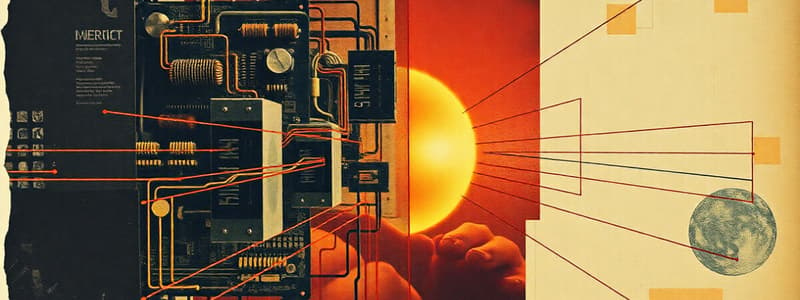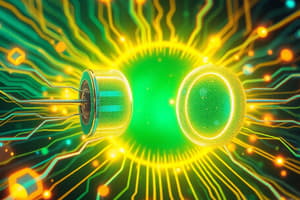Podcast
Questions and Answers
What is an insulator?
What is an insulator?
An insulator is a material that has a very high resistance to the flow of electricity. This means that very little electric current can flow through an insulator. Examples of insulators include rubber, wood, glass, and air.
Which of the following is NOT a property of a semiconductor?
Which of the following is NOT a property of a semiconductor?
- Conductivity increases with increasing temperature
- Conductivity is intermediate to that of conductors and insulators
- Conductivity is always high (correct)
- Conductivity can be increased by adding impurities
In an intrinsic semiconductor, what is the relationship between the number of free electrons and the number of holes?
In an intrinsic semiconductor, what is the relationship between the number of free electrons and the number of holes?
- The number of free electrons is much less than the number of holes
- The number of free electrons is not related to the number of holes
- The number of free electrons is much greater than the number of holes
- The number of free electrons is equal to the number of holes (correct)
What is doping?
What is doping?
In an n-type semiconductor, which type of charge carrier is the majority carrier?
In an n-type semiconductor, which type of charge carrier is the majority carrier?
What is a p-n junction?
What is a p-n junction?
What is the depletion region in a p-n junction?
What is the depletion region in a p-n junction?
What is the barrier potential in a p-n junction?
What is the barrier potential in a p-n junction?
What happens to the width of the depletion region in a p-n junction when it is forward biased?
What happens to the width of the depletion region in a p-n junction when it is forward biased?
What happens to the width of the depletion region in a p-n junction when it is reverse biased?
What happens to the width of the depletion region in a p-n junction when it is reverse biased?
What is a diode?
What is a diode?
What is the difference between a diode and a transistor?
What is the difference between a diode and a transistor?
What is rectification?
What is rectification?
What is a half-wave rectifier?
What is a half-wave rectifier?
What is the dynamic resistance of a diode?
What is the dynamic resistance of a diode?
The forward bias dynamic resistance of a diode is much lower than the reverse bias dynamic resistance.
The forward bias dynamic resistance of a diode is much lower than the reverse bias dynamic resistance.
How is an n-type semiconductor formed?
How is an n-type semiconductor formed?
Flashcards
Conductors
Conductors
Materials with high conductivity (low resistivity), where the conduction band either overlaps with the valence band or is partially filled, enabling free electron movement.
Semiconductors
Semiconductors
Materials with conductivity between conductors and insulators, with a small energy gap between the valence band and conduction band. At room temperature, some electrons can jump to the conduction band.
Insulators
Insulators
Materials with very low conductivity (high resistivity), with a large energy gap between the valence band and conduction band. Electrons cannot easily jump to the conduction band.
Energy Band
Energy Band
Signup and view all the flashcards
Valence Band
Valence Band
Signup and view all the flashcards
Conduction Band
Conduction Band
Signup and view all the flashcards
Energy Gap (Eg)
Energy Gap (Eg)
Signup and view all the flashcards
Intrinsic Semiconductor
Intrinsic Semiconductor
Signup and view all the flashcards
Doping
Doping
Signup and view all the flashcards
n-type Semiconductor
n-type Semiconductor
Signup and view all the flashcards
p-type Semiconductor
p-type Semiconductor
Signup and view all the flashcards
p-n Junction
p-n Junction
Signup and view all the flashcards
Depletion Region
Depletion Region
Signup and view all the flashcards
Barrier Potential (V0)
Barrier Potential (V0)
Signup and view all the flashcards
Forward Current
Forward Current
Signup and view all the flashcards
Reverse Saturation Current
Reverse Saturation Current
Signup and view all the flashcards
Breakdown Voltage (Vbr)
Breakdown Voltage (Vbr)
Signup and view all the flashcards
Rectifier
Rectifier
Signup and view all the flashcards
Half-Wave Rectifier
Half-Wave Rectifier
Signup and view all the flashcards
Full-Wave Rectifier
Full-Wave Rectifier
Signup and view all the flashcards
Rectification
Rectification
Signup and view all the flashcards
Forward Resistance
Forward Resistance
Signup and view all the flashcards
Reverse Resistance
Reverse Resistance
Signup and view all the flashcards
Dynamic Resistance
Dynamic Resistance
Signup and view all the flashcards
Threshold Voltage (Cut-In Voltage)
Threshold Voltage (Cut-In Voltage)
Signup and view all the flashcards
Semiconductor Diode
Semiconductor Diode
Signup and view all the flashcards
Tetravalent Element
Tetravalent Element
Signup and view all the flashcards
Pentavalent Element
Pentavalent Element
Signup and view all the flashcards
Trivalent Element
Trivalent Element
Signup and view all the flashcards
Diffusion Current
Diffusion Current
Signup and view all the flashcards
Drift Current
Drift Current
Signup and view all the flashcards
Doping Process
Doping Process
Signup and view all the flashcards
Study Notes
Semiconductor Electronics: Materials, Devices and Simple Circuits
- Learning Objectives: After studying this unit, learners will understand the classification of solids based on conductivity, energy band theory, intrinsic and extrinsic semiconductors, p-n junction diodes, and their characteristics.
Introduction
- Vacuum Tubes vs. Semiconductor Devices: Semiconductor devices replaced vacuum tubes because they are less bulky, consume less power, and are more reliable.
Classification of Solids
- Conductors: Solids with high conductivity (low resistivity). Conductivity ranges from 10² to 10⁸ S m⁻¹. Examples include aluminum, copper, silver, and gold.
- Insulators: Solids with low conductivity (high resistivity). Conductivity ranges from 10⁻¹¹ to 10⁻¹⁹ S m⁻¹. Examples include rubber, plastic, mica, and glass.
- Semiconductors: Solids with conductivity intermediate to metals and insulators. Conductivity ranges from 10⁻¹ to 10⁶ S m⁻¹ and resistivity ranges from 10⁵ to 10⁹ Ωm. Examples include silicon and germanium.
Band Theory of Solids
- Energy Bands: Closely spaced energy levels in solids form energy bands.
- Valence Band: Energy levels occupied by valence electrons.
- Conduction Band: Energy levels above the valence band, occupied by conduction electrons.
- Energy Gap (Eg): The separation in energy between the valence and conduction bands. A larger energy gap implies an insulator, a smaller energy gap a semiconductor, a gap of zero implies a conductor.
Intrinsic Semiconductor
- Definition: A pure semiconductor with no impurities. Its conductivity is low at absolute zero temperature, but increases progressively with increasing temperature.
- Electron-Hole Pair Generation: Thermal energy enables electrons to jump from the valence band to the conduction band, creating electron-hole pairs (free electrons and holes).
Extrinsic Semiconductor
- Definition: An impure semiconductor with added impurities to increase conductivity.
- Doping: The process of adding impurities to an intrinsic semiconductor.
- N-type Semiconductor: Pentavalent impurities (e.g., phosphorus, arsenic, antimony) are added. The extra valence electrons from the impurity atoms become conduction electrons. Electrons are majority carriers.
- P-type Semiconductor: Trivalent impurities (e.g., boron, aluminum, gallium) are added. The missing valence electrons create 'holes' that behave as positive charge carriers. Holes are majority carriers.
p-n Junction Diode
- Formation: A p-n junction is formed when a p-type and an n-type semiconductor are joined together.
- Depletion Region: A region near the junction where majority charge carriers are depleted, creating an electric field that opposes further diffusion of charge carriers.
- Forward Bias: Applying positive voltage to the p-side and negative voltage to the n-side reduces the barrier potential, allowing current flow.
- Reverse Bias: Applying negative voltage to the p-side and positive voltage to the n-side increases the barrier potential, decreasing current flow.
- Characteristics: The I-V (current-voltage) characteristics of a diode exhibit different behaviors under forward and reverse bias.
Studying That Suits You
Use AI to generate personalized quizzes and flashcards to suit your learning preferences.




